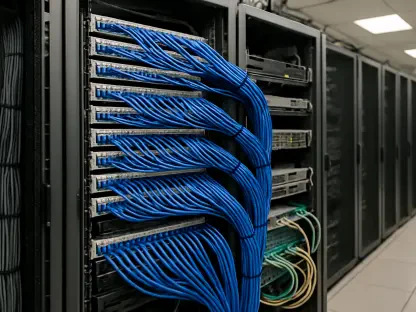Nvidia is making significant strides in revolutionizing data centers by leveraging its advancements in Artificial Intelligence (AI) technology. The company’s GPUs, originally designed for gaming, are now pivotal in AI and machine learning processes, providing unparalleled computation power and efficiency for data centers.
Nvidia Corp. is at the forefront of a transformative shift in the data center market, driven by the rise of artificial intelligence (AI) and extreme parallel computing (EPC). This article delves into Nvidia’s pivotal role in this evolution, examining the integration of hardware, software, systems engineering, and a vast ecosystem that is propelling the data center market towards a valuation of $1.7 trillion by 2035.
The Rise of Extreme Parallel Computing
Shift in Computing Era
We are entering a new computing era where extreme parallel computing is set to dominate the landscape, driven primarily by increasingly complex AI workloads. Nvidia is uniquely positioned at the forefront of this shift, offering a comprehensive platform that integrates hardware, software, and systems engineering to drive industry-wide adoption. This transformation period spans a 10- to 20-year window, during which market forces will extend beyond a single player to encompass an entire re-imagining of computing from the chip level to the data center equipment.
The transition to this new era is marked by significant shifts in technology and infrastructure, reflecting Nvidia’s comprehensive role in this evolution. Nvidia’s strategy leverages advanced hardware, sophisticated software, and robust systems engineering to enable extreme parallel computing. This approach is essential for handling the complex and resource-intensive workloads associated with AI, and it positions Nvidia as a key player in this market. As a result, data centers are being re-architected to accommodate these demands, leading to more efficient and powerful computational capabilities on a global scale.
Role of Nvidia
Nvidia’s role in the evolution of data centers is crucial and multifaceted, as it promotes new paradigms in computing that prioritize speed, efficiency, and scalability. The company’s development of a platform that integrates cutting-edge hardware, software, and systems engineering drives the adoption of extreme parallel computing, essential for processing the vast amounts of data generated by AI applications. Nvidia’s GPUs, with their parallel processing capabilities, provide the computational backbone necessary for these advancements, making them indispensable in the data center infrastructure.
Nvidia Corp. stands at the vanguard of a significant transformation in the data center industry, driven by the burgeoning fields of artificial intelligence (AI) and extreme parallel computing (EPC). This shift is catalyzing a revolution within data centers, underscored by Nvidia’s groundbreaking contributions in hardware, software, and systems engineering. Nvidia’s advanced GPUs and AI capabilities are crucial in handling the massive computational demands of modern applications, enabling more efficient processing and analysis of data.
With an extensive ecosystem comprising a range of partners and developers, Nvidia is not only enhancing the capabilities of data centers but also driving innovation across multiple sectors. This robust integration ensures that the evolving needs of the market are met, paving the way for new possibilities in computing and data management.
As Nvidia continues to spearhead advancements, it is anticipated that their influence will help push the data center market to an impressive valuation of $1.7 trillion by the year 2035. The synergy between cutting-edge technology and a comprehensive support network highlights Nvidia’s essential role in shaping the future of data processing and AI-driven solutions. The company’s ongoing efforts in research and development emphasize their unwavering commitment to leading the charge in this rapidly growing and dynamic landscape. This comprehensive approach ensures it remains a key player in this rapidly evolving market, reinforcing its leadership across various technological fronts. By integrating advanced nodes and specialized tensor cores designed for AI performance, Nvidia optimizes yields across multiple markets, continually pushing the envelope in compute performance. The company’s acquisition of Mellanox and control over high-performance networking technologies like InfiniBand have further cemented its position. Nvidia, a leading company in graphics processing technology, has made significant strides in the ever-evolving tech landscape. Their innovations have continuously pushed the boundaries of what is possible in visual computing and artificial intelligence.
By consistently developing new and advanced GPUs, Nvidia has been at the forefront of powering cutting-edge graphics in various industries such as gaming, professional visualization, data centers, and automotive. Their GPUs are not just limited to gaming but have also become essential tools for professionals in fields like animation, film production, and product design due to their exceptional rendering capabilities.
Furthermore, Nvidia’s impact on artificial intelligence cannot be overstated. Their GPUs have revolutionized the way AI algorithms are run, making them faster and more efficient. This advancement has had a profound impact on industries such as healthcare, finance, and autonomous vehicles, where AI applications are continually being developed and deployed.
Nvidia’s commitment to research and development ensures they remain a dominant force in technology innovation. By investing heavily in groundbreaking technologies and expanding their reach into new markets, Nvidia continues to chart a course that shapes the future of computing and artificial intelligence. Their contributions to the tech world have not only redefined the standards of performance and capability but have also opened up new possibilities and applications across a multitude of industries.
Looking forward, Nvidia is poised to continue its trajectory of innovation, providing the tools and technologies that will power the digital experiences of tomorrow. As they keep pushing the envelope, Nvidia’s influence will likely continue to grow, solidifying their position as a pivotal player in the tech industry. Their robust software ecosystem, built around CUDA, continues to attract and retain developers, fostering an environment where innovation can thrive. This holistic strategy encapsulates Nvidia’s push to fundamentally transform how data centers operate.
Components of the Technological Stack
Compute
The transition from traditional x86 architectures to specialized accelerators such as GPUs is occurring more rapidly than many industry experts had anticipated, primarily driven by the intensive requirements of AI workloads like large language models and advanced analytics. GPUs, with their thousands of cores, offer significantly more affordable compute solutions on a per-unit basis due to their inherently parallel design. This design’s efficacy is particularly evident in large GPU clusters, which feature high-bandwidth memory and fast interconnects like InfiniBand, enabling the efficient processing of new, demanding AI workloads.
The shift towards these specialized accelerators represents a fundamental change in the computational landscape, aligning with the needs of contemporary AI applications. GPU clusters are capable of handling the massive concurrency required by these applications, ensuring that data processing can happen at unprecedented speeds and scales. Furthermore, the use of advanced interconnects facilitates low-latency, high-throughput data transfer within these clusters, optimizing the overall performance and efficiency of data center operations. This shift underscores the necessity of rethinking traditional computing models to better support the scale and complexity of modern AI tasks.
Storage
Proper storage is essential to maintain the quality and longevity of your items.
AI demands exceptionally high-performance storage solutions, as anticipatory data staging ensures that critical data resides near processors, thereby reducing latency and enabling faster access. Distributed file stores with petabyte-scale capacities and metadata-driven intelligence are instrumental in orchestrating data placements across nodes, ensuring that data is readily available for processing when needed. These storage systems are essential in maintaining the flow of data to GPUs and other accelerators, which is crucial for the seamless execution of AI workloads.
Performance layers such as NVMe SSDs, all-flash arrays, and high-throughput data fabrics play a vital role in this ecosystem, providing the necessary speed and efficiency to handle the vast amounts of data generated and processed by AI applications. These advanced storage solutions ensure that data is not only stored efficiently but also accessed quickly, minimizing bottlenecks and maximizing computational efficiency. This combination of high-performance storage and intelligent data management is key to supporting the next generation of AI-driven data centers, enabling them to operate at peak performance levels.
Networking
The massive bidirectional traffic generated by AI workloads within data centers necessitates ultra-high-bandwidth and low-latency networking fabrics to ensure optimal performance. Advanced networking standards such as InfiniBand and high-performance Ethernet are essential in facilitating the parallel operations of AI clusters, enabling them to process and transfer data at the speeds required by modern AI applications. These hyper-scale networks are crucial for supporting the massive data flows required by AI, ensuring that data is quickly and efficiently routed to and from various processing nodes.
The implementation of these advanced networking technologies is a critical component in the overall architecture of AI-driven data centers. By providing the necessary bandwidth and low-latency connections, these networks enable seamless communication between different components of the data center, optimizing the flow of data and maximizing computational efficiency. This connectivity is essential for scaling AI applications effectively, allowing data centers to handle increasingly complex and large-scale workloads without compromising performance.
Software Stack and Tooling
Operating systems, middleware, libraries, and application frameworks must be meticulously optimized to leverage the full potential of GPU resources and manage unprecedented levels of concurrency associated with AI workloads. Nvidia’s software stack is designed to handle these demands, offering a suite of tools and frameworks that enable developers to build, deploy, and manage AI applications efficiently. From CUDA, the foundational platform that abstracts GPU complexities, to specialized libraries and toolkits, Nvidia provides a comprehensive ecosystem that supports every stage of AI development.
The data layer within this ecosystem evolves from traditional historical analytics to real-time engines, facilitating the creation of digital twins that represent entire organizations. These real-time engines enable organizations to model and simulate complex scenarios, providing valuable insights and optimizing decision-making processes. Additionally, the application layer is witnessing the emergence of intelligent applications that unify and harmonize data, understand human language, and support workflow automation. This integrated approach ensures that AI applications can operate seamlessly, leveraging the full power of Nvidia’s hardware and software innovations to deliver unprecedented performance and efficiency.
Performance and Competition Among Semiconductor Players
The semiconductor industry has seen significant shifts in performance and competition among key players, driven by rapid technological advancements and market demands. Major companies are investing heavily in research and development to stay ahead in the race for more efficient and powerful chips.
Nvidia’s Market Position
In recent years, Nvidia has solidified its place as a dominant force in the technology sector, particularly in the realms of graphics processing units (GPUs) and artificial intelligence (AI). The company’s cutting-edge innovations and strategic partnerships have propelled it to the forefront of several burgeoning markets, thus ensuring its competitive advantage in an increasingly digital world.
Nvidia has emerged as the most valuable public company in the realm of AI, buoyed by the industry’s increasing enthusiasm for the potential of artificial intelligence and extreme parallel computing. The company’s stock performance has significantly outpaced its competitors, driven by its leadership in AI and the development of a comprehensive platform that integrates hardware, software, and systems engineering. Nvidia’s extensive ecosystem and innovative approach have solidified its position as a market leader, making it a pivotal player in the rapidly evolving data center landscape.
Nvidia’s strategic investments and acquisitions have further strengthened its market position, enabling it to offer a holistic solution for AI-driven data centers. The company’s ongoing commitment to innovation and its ability to anticipate and respond to market needs have ensured that it remains at the forefront of this technological revolution. As AI continues to drive demand for more powerful and efficient data center solutions, Nvidia’s leadership role is expected to grow, positioning the company for continued success in the years to come.
Competitors’ Strategies
Competitors are continually evolving their strategies to maintain a competitive edge and adapt to market changes. By implementing innovative approaches and leveraging new technologies, they aim to offer unique value propositions to gain customer loyalty and differentiate themselves from others in the industry. Understanding and analyzing competitors’ strategies can provide valuable insights for businesses to refine their own tactics and achieve sustainable growth.
Despite Nvidia’s dominance, several key competitors are making significant strides in the AI and data center markets, each employing distinct strategies to capture a share of this lucrative market. Broadcom, for instance, is recognized as a strong AI player in silicon, providing critical intellectual property (IP) to cloud giants. The company’s expertise in semiconductor technology and its ability to deliver high-performance solutions have made it a formidable competitor in this space.
On the other hand, AMD has made notable progress in the x86 market and is pushing into the AI sector, albeit with some challenges. While AMD has succeeded in outperforming Intel, it faces hurdles in replicating Nvidia’s comprehensive software stack, which is crucial for maintaining developer loyalty and optimizing AI workloads. Intel, currently struggling with its foundry strategy, faces internal challenges that have limited its focus on design and innovation. Qualcomm has directed its efforts towards mobile, edge, and device-centric AI but does not directly compete in the data center segment. Each player’s strategy reflects their unique strengths and market positions, contributing to a dynamic and competitive landscape.
Unified Trends and Viewpoints
Nvidia’s Competitive Landscape
As Nvidia continues to dominate the GPU market, it faces increasing competition from companies like AMD and Intel, who are making significant strides in their own graphics technologies. This competitive landscape pushes Nvidia to innovate continually, ensuring that they maintain their market leader status while meeting the growing demands of consumers and industries alike.
Nvidia faces a competitive landscape marked by formidable rivals and innovative strategies aimed at capturing parts of the AI and data center markets. Broadcom and Google, leveraging Broadcom’s IP and Google’s Tensor Processing Units (TPUs), present a viable technical alternative to Nvidia’s solutions. This collaboration underscores the potential return on investment (ROI) AI brings to enterprises, as evidenced by Meta’s partnership with Broadcom to power AI chips. These collaborations highlight the growing importance of AI in driving business value and the willingness of major industry players to invest in advanced AI technologies.
AMD continues its efforts to capture a share of the AI market through its expertise in GPU technology, although it faces significant challenges in replicating Nvidia’s sophisticated software stack. Intel’s capital-intensive foundry strategy has limited its ability to focus on design and innovation, placing it at a disadvantage in the rapidly evolving AI market. Amazon Web Services (AWS) has also entered the fray, employing custom silicon solutions like Trainium and Inferentia to offer cost-optimized AI alternatives within its ecosystem. These dynamics illustrate a highly competitive environment where numerous players are vying for leadership in the AI-driven data center market.
Inside Nvidia’s Moat
Nvidia’s comprehensive moat spans across hardware, software, and a robust ecosystem, positioning it as a leader in the AI and data center markets. The company integrates advanced semiconductor nodes and specialized tensor cores specifically designed for AI performance, optimizing yields across various markets. Nvidia’s acquisition of Mellanox and control over high-performance networking technologies like InfiniBand have further enhanced its AI cluster offerings, enabling the creation of comprehensive and efficient data center systems.
The strength of Nvidia’s software ecosystem is another critical component of its competitive advantage. Built around the CUDA platform, this ecosystem includes numerous frameworks and tools designed to support various stages of AI application development, increasing developer loyalty and fostering innovation. Nvidia’s extensive partner network also creates significant network effects, bolstering its overall market position. These strategic investments and initiatives ensure that Nvidia maintains its leadership role, driving advancements in AI and data center technologies while supporting a vibrant and growing developer community.
Software Stack: Detailed Examination
undefined
CUDA, or Compute Unified Device Architecture, serves as the foundational platform for Nvidia’s extensive software ecosystem. It abstracts the complexities of GPU programming, allowing developers to optimize workloads for AI, high-performance computing (HPC), and graphics applications without being bogged down by the intricate details of GPU architecture. This abstraction layer simplifies the development process, making it accessible to a broader range of developers and enabling them to harness the full computational power of Nvidia’s GPUs. The wide adoption of CUDA has fostered a vibrant developer community, further cementing Nvidia’s position as a leader in the AI and data center markets.
NIMS, or Nvidia Inference Microservices, is another critical component of Nvidia’s software stack. This set of inference microservices facilitates the deployment of foundational AI models across various cloud environments. NIMS provides the necessary infrastructure to deploy and manage AI models at scale, enabling developers to build robust and scalable AI applications. These tools are essential for developers working on AI applications, providing the necessary infrastructure to build and deploy complex models efficiently. The combination of CUDA and NIMS ensures that Nvidia’s software ecosystem remains robust, flexible, and capable of supporting a wide range of AI workloads.
NeMo and Omniverse
NeMo is a framework specifically designed for developing natural language processing (NLP) applications, enabling the creation and deployment of sophisticated models that can understand and generate human language. This framework supports a wide range of NLP tasks, including text generation, translation, and sentiment analysis, making it a powerful tool for developers working in the field of AI. NeMo also allows models to be exported into other Nvidia products, ensuring seamless integration across Nvidia’s ecosystem and enhancing the overall flexibility and usability of these models.
Omniverse is another innovative platform from Nvidia, designed for 3D collaboration and simulation. This platform extends into various domains, including digital twins and robotics, enabling the creation of highly detailed and accurate simulations of real-world environments. Omniverse allows teams to collaborate in real-time, making it an invaluable tool for industries ranging from entertainment to engineering. By providing a unified platform for 3D modeling, simulation, and collaboration, Omniverse enhances the efficiency and effectiveness of project workflows, driving innovation and improving outcomes across various sectors.
Performance and Competition Among Semiconductor Players
Nvidia’s Market Position
Nvidia’s significant lead in the AI-driven data center market results from its innovative technologies and comprehensive platform, which integrates advanced hardware, sophisticated software, and robust systems engineering. Under AI enthusiasm, Nvidia has emerged as the most valuable public company. Nvidia’s stock performance also highlights this fact, outpacing its major competitors. The continued expansion of Nvidia’s ecosystem strengthens it as a market leader. As a result, the company’s ability to push the boundaries of technology and maintain a competitive edge is highlighted by its success in the marketplace.
Furthermore, as the demand for AI-driven solutions continues to grow, Nvidia’s leadership in developing and delivering high-performance computing solutions will only become more crucial. Its strategic partnerships, acquisitions, and continued investment in R&D ensure that Nvidia remains at the forefront of technological innovation, further solidifying its market position. The company’s ability to anticipate and respond to market needs positions it for continued success. Nvidia’s robust approach underscores its long-term vision and commitment to driving the future of AI and data center technologies.
Competitors’ Strategies
Competitors are employing a variety of strategies to gain market share and enhance their positions. Some are prioritizing innovation and investment in new technologies, while others focus on expanding their services and geographical reach. Additionally, many are forming strategic partnerships and alliances to strengthen their market presence and improve operational efficiencies.
Despite Nvidia’s dominance, several key competitors are making significant strides to capture a share of the AI and data center markets through distinct strategies addressing unique market opportunities. Noteworthy among them, Broadcom is recognized as a formidable AI player in the silicon space, providing critical intellectual property (IP) to cloud giants. The company’s expertise in semiconductor technology and its robust portfolio of solutions have positioned it as a strong competitor, capable of addressing the high-performance needs of AI workloads.
Conversely, AMD has demonstrated notable progress in the x86 market and is extending its reach into the AI sector. However, AMD faces hurdles in replicating Nvidia’s comprehensive software stack, essential for maintaining developer loyalty and optimizing AI workloads. Intel, currently grappling with its foundry strategy, is constrained by internal challenges that inhibit its ability to innovate at the same pace as its competitors. Meanwhile, Qualcomm has focused on mobile, edge, and device-centric AI but does not directly compete in the data center segment. These diverse strategies reflect each player’s strengths and market positions, contributing to a dynamic and competitive landscape in the AI and data center markets.
Unified Trends and Viewpoints
Nvidia’s Competitive Landscape
Amid a competitive landscape, Nvidia faces aggressive entry by rivals leveraging innovative strategies to capture segments of the AI and data center markets. For instance, Broadcom and Google, by combining Broadcom’s intellectual property (IP) with Google’s Tensor Processing Units (TPUs), shape a viable technical alternative to Nvidia’s solutions. This collaboration underscores AI’s potential to drive business value, as evidenced by Meta’s partnership with Broadcom to power AI chips. These developments highlight the increasing strategic importance of AI in businesses and the collaborative efforts of industry leaders to advance AI technologies.
AMD also continues striving to capture a share of the AI market through its expertise in GPU technology. However, it confronts significant challenges in replicating Nvidia’s sophisticated software stack, a key aspect in retaining developer loyalty and optimizing AI workloads. Intel’s focus on a capital-intensive foundry strategy has limited its ability to innovate and maintain a competitive edge. Meanwhile, Amazon Web Services (AWS) introduces cost-optimized AI solutions within its ecosystem using custom silicon like Trainium and Inferentia. These dynamics underscore the highly competitive environment, marked by strategic technological advancements and varied market approaches by different players, all attempting to lead the AI-driven data center market.
Inside Nvidia’s Moat
Nvidia has built a formidable moat that encompasses hardware innovations, software advancements, and an expansive ecosystem, reinforcing its leading position in the AI and data center markets. Key to this moat is Nvidia’s integration of advanced semiconductor nodes and specialized tensor cores that are optimized for AI performance, ensuring high yields across various market segments. Another strategic move was Nvidia’s acquisition of Mellanox and control over high-performance networking technologies, such as InfiniBand, which has enhanced its AI cluster offerings by enabling comprehensive and efficient data center systems.
Further fortifying Nvidia’s competitive edge is its robust software ecosystem, anchored by the CUDA platform. This ecosystem includes a wide array of tools and frameworks that support AI application development, boosting developer loyalty and fostering continuous innovation. Nvidia’s extensive network of partners also generates significant network effects, further strengthening its market position. These strategic initiatives ensure that Nvidia is not only maintaining its leadership but also advancing the cutting edge of AI and data center technologies. As Nvidia continues to innovate systems that perfectly align hardware with software, its position in the market is well-guarded and poised for future growth.
Software Stack: Detailed Examination
The software stack, a crucial element in the development and maintenance of applications, comprises various layers that work together to deliver a seamless user experience. From the operating system to the application itself, each layer serves a specific purpose and ensures that the entire system functions efficiently. Understanding the intricacies of the software stack is essential for developers to optimize performance and provide robust solutions.
undefined
CUDA (Compute Unified Device Architecture), Nvidia’s flagship software platform, serves as the foundation for an extensive and powerful ecosystem that supports AI, high-performance computing (HPC), and graphics applications. By abstracting the complexities of GPU programming, CUDA allows developers to optimize workloads effectively, tapping into the immense computational power of Nvidia’s GPUs without requiring in-depth knowledge of the hardware architecture. This capability has significantly broadened GPU accessibility, driving widespread adoption and fostering a vibrant developer community that continually innovates within the ecosystem.
In addition to CUDA, Nvidia offers the NIMS (Nvidia Inference Microservices) suite, which facilitates the deployment of foundational AI models across diverse cloud environments. NIMS enables developers to create scalable, robust AI applications by providing the necessary infrastructure to build, deploy, and manage inference models efficiently. These microservices play a critical role in translating AI research into practical applications, enhancing the agility and performance of AI implementations across multiple platforms. Together, CUDA and NIMS form a comprehensive toolkit that empowers developers to push the boundaries of AI technology.
NeMo and Omniverse
NeMo (Nvidia ExaScale Machine Learning Opensource) framework is specifically designed to cater to developers focusing on natural language processing (NLP) applications. This robust framework supports the creation and deployment of sophisticated models capable of understanding and generating human language, addressing various NLP tasks such as text generation, translation, and sentiment analysis. By enabling seamless integration with other Nvidia products, NeMo ensures that developers can leverage the full scope of Nvidia’s ecosystem, thus enhancing the flexibility and usability of their NLP models. This integration is crucial for advancing the capabilities of AI in understanding and processing human language across various applications.
Another significant innovation from Nvidia is Omniverse, a platform engineered for 3D collaboration and simulation that has extensive applications in digital twins, robotics, and beyond. Omniverse enables teams to collaborate in real-time, providing a unified platform for creating detailed and accurate simulations of real-world environments. This capability is invaluable across numerous industries, from entertainment to engineering, facilitating enhanced project workflows and the rapid iteration of complex models. By driving innovation and improving outcomes, Omniverse exemplifies Nvidia’s commitment to developing comprehensive solutions that address the needs of modern industries, fostering a more collaborative and efficient approach to 3D modeling and simulation.
Performance and Competition Among Semiconductor Players
Nvidia’s Market Position
Nvidia’s









